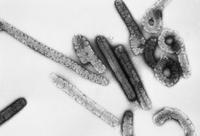-
A combination ricin/anthrax vaccine shows promise
Soligenix, Inc. last month announced the publication of data demonstrating that the combination of RiVax and VeloThrax induces protective immunity to both ricin toxin and anthrax toxin exposure. RiVax is the company’s candidate vaccine for the prevention of exposure to ricin toxin using an antigen which is completely devoid of the toxic activity of ricin. VeloThrax is the company’s candidate vaccine which employs a derivative of recombinant protective antigen, termed Dominant Negative Inhibitor (DNI), which is a candidate for inclusion in a next generation anthrax vaccine.
-
-
Studying cancer risks near nuclear facilities
The National Academy of Sciences has issues a brief report which provides an expert committee’s advice about general methodological considerations for carrying out a pilot study of cancer risks near seven nuclear facilities in the United States. The pilot study will assess the feasibility of two approaches that could be used in a nationwide study to analyze cancer risk near nuclear facilities regulated by the U.S. Nuclear Regulatory Commission (NRC).
-
-
IMF-imposed reforms undermined healthcare provision in Ebola-stricken West Africa
Researchers criticize reforms advocated by the International Monetary Fund (IMF) for chronically under-funded and insufficiently staffed health systems in Guinea, Liberia, and Sierra Leone. They say these policies contributed to “lack of preparedness” of West African health systems to cope with disease and emergencies such as Ebola. The researchers argue that IMF programs over the years have imposed heavy constraints on the development of effective health systems of Guinea, Liberia, and Sierra Leone — the cradle of the Ebola outbreak that has killed more than 6,800 since March this year.
-
-
2014: A trying year for U.S. health agencies
2014 has been a trying year for U.S. health officials. Globalization and the movement of people from previously remote villages to large cities introduced diseases such as Ebola to places where the flu virus was once considered the most alarming public health scare. “If anyone still needed convincing, 2014 really showed that a disease threat anywhere is a disease threat everywhere,” said Dr. Tom Frieden, CDC director. A series of mishaps in handling deadly pathogens in CDC and NIH labs raised questions about the safety culture in U.S. biolabs.
-
-
Progress made in slowing Ebola spread in West Africa – but it is still spreading
Nearly 20,000 people have been infected with the Ebola virus since December 2013, and about 7,700 of them have died. Over 90 percent of patients live in West Africa, where poor public healthcare systems have accelerated the spread of the disease. As 2015 approaches, healthcare officials in West Africa are seeing progress in eradication efforts. Ebola-infected dead bodies are being picked up from the streets of major towns and properly buried by government workers, and more patients are being admitted to hospitals due to an increase in the number of hospital beds available. Yet, despite the progress made in recent weeks, Ebola is still spreading in remote villages. “It is encouraging to see that when we get to a place where Ebola is spreading quickly, we can end that cluster within a month or two,” said one expert. “But the problem is, there are clusters all over, and new ones popping up all the time,” adding: “This is going to be a long, hard fight.”
-
-
One million curies of radioactive material safely recovered
Experts at the Los Alamos National Laboratory (LANL) helped the Department of Energy’s (DOE) Off-Site Source Recovery Project (OSRP) recover more than one million curies of radioactive sources since 1999. LANL says that the accomplishment represents a major milestone in protecting our nation and the world from material that could be used in “dirty bombs” by terrorists. “Taking disused, unwanted and, in limited cases, abandoned nuclear materials out of harm’s reach supports the Laboratory’s mission of reducing global nuclear danger,” said Terry Wallace, principal associate director for global security at Los Alamos.
-
-
Fear of terrorism increases basal (resting) heart rate, risk of death
A new study of over 17,000 Israelis has found that long-term exposure to the threat of terrorism can elevate people’s resting heart rates and increase their risk of dying. This is the first statistics-based study, and the largest of its kind, which indicates that fear induced by consistent exposure to the threat of terror can lead to negative health consequences and increase the risk of mortality. “We found that fear of terrorism and existential anxiety may disrupt the control processes using acetylcholine, causing a chronic accelerated heart rate. Together with inflammation, these changes are associated with increased risk of heart attack and stroke,” one of the researchers said.
-
-
Could the Sydney siege have been predicted and prevented?
It’s the question everyone is asking — could the Sydney siege have been predicted and therefore prevented based on the past behavior of gunman Man Haron Monis. Monis’s troubled history was well known to media and the police, but can we predict if and when such a person is likely to commit any further crimes? Further, we need to be very careful about stereotyping the mentally ill as potentially “dangerous.” It is simply not the case that all people with serious mental illnesses are prone to violence. There are very specific factors that govern the complex relationship between mental illness and violence. We need to understand and prevent people from experiencing them.
-
-
Improved protective suit for Ebola caregivers
An advanced protective suit for health care workers who treat Ebola patients, devised by a Johns Hopkins University team, is one of the first five awardees in a federal funding contest aimed at quickly devising new tools to combat the deadly disease. The JHU prototype is designed to do a better job than current garments in keeping health care workers from coming in contact with Ebola patients’ contagious body fluids, both during treatment and while removing a soiled suit. In addition, it is expected to keep the wearer cooler — an important benefit in hot, humid regions such as West Africa.
-
-
Preventing animal-borne diseases from affecting humans

Roughly 75 percent of newly emerging diseases are zoonotic, which means that they can spread from animals to humans. Incredibly damaging, these diseases usually wreak havoc on humans, who rarely have natural defenses to protect them against such strains. About 2.7 million people die each year from zoonotic diseases. It is estimated that between 1997 and 2009, the cost of dealing with and treating these types of diseases around the world amounted roughly $80 billion. Scientists hope that by connecting human medical and veterinary science, and by organizing and establishing different medical professionals along a spectrum of disease detection, it would be possible to thwart the outbreak of another zoonotic disease.
-
-
Murder charges against leaders of compounding company whose adulterated product killed 64
In the fall of 2012, 751 people in twenty states fell ill and sixty-four died from a fungal meningitis outbreak shortly after receiving injections of preservative-free methylprednisolone acetate produced at the New England Compounding Center (NECC), a Massachusetts-based compounding pharmacy. Fourteen people connected to NECC are facing a 131-count indictment, with Barry Cadden, co-founder of the company, and Glenn Adam Chin, a pharmacist who ran the sterile room, facing second-degree murder charges.
-
-
Mecca faces severe air pollution during annual pilgrimage

Dangerously high levels of air pollutants are being released in Mecca during the hajj, the annual holy pilgrimage in which millions of Muslims on foot and in vehicles converge on the Saudi Arabian city, according to findings of a new study. “Hajj is like nothing else on the planet. You have 3 to 4 million people — a whole good-sized city — coming into an already existing city,” said one researcher. “The problem is that this intensifies the pollution that already exists. We measured among the highest concentrations our group has ever measured in urban areas — and we’ve studied seventy-five cities around the world in the past two decades.”
-
-
U.S. Army seeking to end environmental testing at Indiana nuclear firing range
The U.S. Army wants to end its Nuclear Regulatory Commission (NRC) license at the Jefferson Proving Ground in southern Indiana. The Army’s appeal comes after years of water and soil testing at the site. Currently, an estimated 162,040 pounds of depleted uranium projectiles and shows are still on the firing range. The site was last used in 1995. Uranium munitions, specifically the kind used to penetrate armor during Operation Desert Shield, were used there throughout the 1980s and 1990s.
-
-
Link between power lines and ill-health called into question

Several past studies have suggested that the magnetic fields created by phones, high-voltage power lines, and other electrical equipment are harmful for humans. Research first carried out in the 1970s and again subsequently, found an association between people living near overhead power lines and an increased risk of childhood leukemia, and the International Agency for Research on Cancer has categorized low frequency magnetic fields as “possibly carcinogenic.” A mechanism for this association has never been found, and now a research team studying the effects of weak magnetic fields (WMFs) on key human proteins, including those crucial for health, found that they have no detectable impact.
-
-
Can a hacker stop your car or your heart? Security and the Internet of Things
An ever-increasing number of our consumer electronics is Internet-connected. We’re living at the dawn of the age of the Internet of Things. Appliances ranging from light switches and door locks, to cars and medical devices boast connectivity in addition to basic functionality. The convenience can’t be beat, but the security and privacy implications cannot and should not be ignored. There needs to be a concerted effort to improve security of future devices. Researchers, manufacturers and end users need to be aware that privacy, health and safety can be compromised by increased connectivity. Benefits in convenience must be balanced with security and privacy costs as the Internet of Things continues to infiltrate our personal spaces.
-
More headlines
The long view
Ransomware Attacks: Death Threats, Endangered Patients and Millions of Dollars in Damages
A ransomware attack on Change Healthcare, a company that processes 15 billion health care transactions annually and deals with 1 in 3 patient records in the United States, is continuing to cause massive disruptions nearly three weeks later. The incident, which started on February 21, has been called the “most significant cyberattack on the U.S. health care system” by the American Hospital Association. It is just the latest example of an increasing trend.
